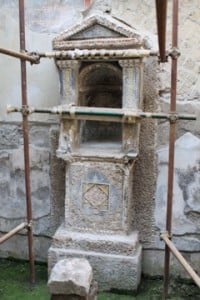Another Tuesday Time Travel…

When visiting various ancient households in and near Rome, one will notice the presence of the lararium in most homes (right). This niche served as a place for adorning the household Lar (pl. Lares), a ‘spirit’ who would protect the home and property. Wealthy households would often contain an elaborate lararium, but even apartment dwellers would save a place on a wall-shelf or cabinet for the Lar. One ancient inscription demonstrating the prominence of the lararium in making ‘home’ feel like ‘home’ is found on a wall in Pompeii:
Gladly we came here, but much more gladly do we depart, eager to see again, O Rome, our own Lares.*
Christians in a Superstitious World

Imagine now new Christian converts in Rome receiving exhortations against such idolatry. Imagine the conflict which might erupt if only the wife in a household converts to Christianity and refuses to pay homage before the lararium (which was established by the pater familias, the head of the family).** Certainly such an attitude would run against the grain of the culture (recall the structure of Roman families as summarized in a previous post).
But Christians did not need the superstitious protection of the so-called Lares; they were “protected by the power of God through faith for a prepared deliverance to be revealed in the last time” (1 Pet. 1:5). Many modern readers of the NT assume that abstaining from idolatrous practices would be a relatively simple decision, but this is not the case in the first century. Refusing to participate in certain pagan activities (and there are many beyond this example!) carried severe social ramifications, especially as hostility toward Christianity grew in the mid to late first century.
*Translation from the Corpus Inscriptionum Latinarum by Jo-Anne Shelton in As the Romans Did: A Sourcebook in Roman Social History (Oxford: Oxford University Press, 1998), 328.
**See Ferguson’s discussion in Backgrounds of Early Christianity (2003) which relies heavily on David G. Orr’s article, “Roman Domestic Religion: The Evidence of the Household Shrines,” ANRW II, Principat, 16.2 (Berlin and New York, 1978), 1557-91.
[…] Read the full post here. […]